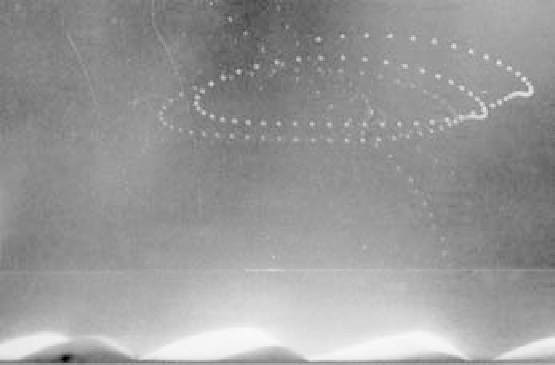Geoscience Reference
In-Depth Information
Fig. 4.56
These oscillation wave ripples formed in sand on the bed of a laboratory channel are being generated under progressive shallow water
waves. Water depth is about two ripple wavelengths and the period of the surface waves is
c.
3 s. The small illuminated dots are reflected light
from a small neutrally buoyant marker particle that has been photographed stroboscopically. The pattern is noteworthy for its demonstration of
Stokes wave drift, whereby net forward motion occurs in shallow water waves. This engenders a net forward sediment transport vector and a for-
ward asymmetry to the ripple forms.
Fig. 4.57
Marta paddling beside a group of spectacular steep and linear symmetrical wave formed ripples developed on sand. The ripples
developed under storm wave conditions, probably with some amplification in the beach inlet.
waves break under a critical vertical gradient in imposed
shear and create turbulence. Because of the Coriolis effect
the efficacy of the resulting mixing process decreases equa-
torward. Progressive internal waves commonly develop at
the shelf edge and in fjords in summer months when shelf
waters are relatively undisturbed by storms and when ther-
mal stratification is at maximum. Erosion of fine-grained
substates by internal wave motion is thought to cause
enhanced sediment suspension that is “captured” in the
interfacial zone of influence of internal wave oscillations.
Once established, these interfacial layers of enhanced con-
centration (termed
nepheloid layers
) may drift shoreward
or oceanward. The density interfaces formed by the strati-
fication may trap organic suspensions stirred-up from the
bottom or derived from settling from the oceanic photic
zone above. Combined with any tendency for summer
upwelling, the sites of internal wave generation may thus
focus organic productivity.
4.11
Granular gravity flow
At home we are familiar with granular flow, dawdling over
the breakfast table with a jar of muesli or cereal, a pot of
sugar crystals, or a salt cellar. Each of these materials is a
granular aggregate, quite stable within its container walls


Search WWH ::

Custom Search